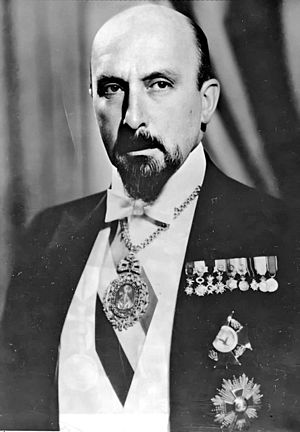Mamerto Urriolagoitía facts for kids
Quick facts for kids
Mamerto Urriolagoitia
|
|
|---|---|
 |
|
| 43rd President of Bolivia | |
| In office 24 October 1949 – 16 May 1951 Acting: 7 May 1949 – 24 October 1949 |
|
| Preceded by | Enrique Hertzog |
| Succeeded by | Hugo Ballivián |
| 26th Vice President of Bolivia | |
| In office 10 March 1947 – 24 October 1949 |
|
| President | Enrique Hertzog |
| Preceded by | Julián Montellano |
| Succeeded by | Hernán Siles Zuazo |
| Minister of Foreign Affairs and Worhsip | |
| In office 10 March 1947 – 14 May 1947 |
|
| President | Enrique Hertzog |
| Preceded by | Aniceto Solares |
| Succeeded by | Luis Fernando Guachalla |
| Personal details | |
| Born |
Mamerto Urriolagoitia Harriague
5 December 1895 Sucre, Bolivia |
| Died | 4 June 1974 (aged 78) Sucre, Bolivia |
| Political party | Republican Socialist Unity (1946–1974) United Socialist (1936–1946) Republican (before 1936) |
| Spouse | Juana Hernandez |
| Parents | Mamerto Urriolagoitía Corina Harriague |
| Education | University of Saint Francis Xavier |
| Awards | Order of the Condor of the Andes Order of Charles III Order of Isabella the Catholic |
| Signature |  |
Mamerto Urriolagoitia Harriague (born December 5, 1895 – died June 4, 1974) was a Bolivian lawyer and politician. He served as the 43rd President of Bolivia from 1949 to 1951. Before becoming president, he was the 26th Vice President of Bolivia from 1947 to 1949, working under President Enrique Hertzog. He was a member of the Republican Socialist Unity Party.
Contents
Life and Political Career
Mamerto Urriolagoitia came from a wealthy family. He studied in France and later became a diplomat for Bolivia.
Becoming Vice President
In 1947, Urriolagoitia was elected Vice President alongside President Enrique Hertzog. During this time, many people, especially those who were poor, wanted big changes in the country. There was a lot of pressure for the government to make reforms.
Time as President
Urriolagoitia was known for being very strict with people who disagreed with the government. Powerful and wealthy groups, who were worried about losing their influence, preferred him. In 1949, these groups pushed President Hertzog to resign. This led to Urriolagoitia becoming the new president.
As president, he quickly tried to stop the movement that wanted big changes. This movement was growing around the Movimiento Nacionalista Revolucionario (Nationalist Revolutionary Movement), led by figures like Víctor Paz Estenssoro, Juan Lechín, and Hernán Siles Zuazo.
Civil Unrest and the "Mamertazo"
Because of the government's strict actions, a series of violent rebellions happened across the country. This period is known as the Civil War of May–September 1949. Urriolagoitia's government managed to regain control, but the old system of powerful families controlling the country was weakening.
By the 1951 presidential elections, the old political system was truly struggling. The opposition party, led by Víctor Paz Estenssoro, won the election. However, at that time, only about 200,000 privileged, educated, and wealthy Bolivians were allowed to vote.
Urriolagoitia refused to hand over power to Paz Estenssoro. Instead, on May 16, 1951, he put the head of the Bolivian military, General Hugo Ballivián Rojas, in charge as president. This action was seen as a coup against the democratic process and became known as the "Mamertazo" of 1951. After the elections were canceled and Ballivián was in power, Urriolagoitia left Bolivia.
Later Life
Mamerto Urriolagoitia retired from politics. He returned to Bolivia years later and passed away in his hometown of Sucre on June 4, 1974, at the age of 78.
He is mostly remembered for his strong and unyielding approach. He was the last constitutional president of the old political system that ruled Bolivia until the Bolivian National Revolution in 1952.
See also
 In Spanish: Mamerto Urriolagoitia para niños
In Spanish: Mamerto Urriolagoitia para niños
Images for kids


